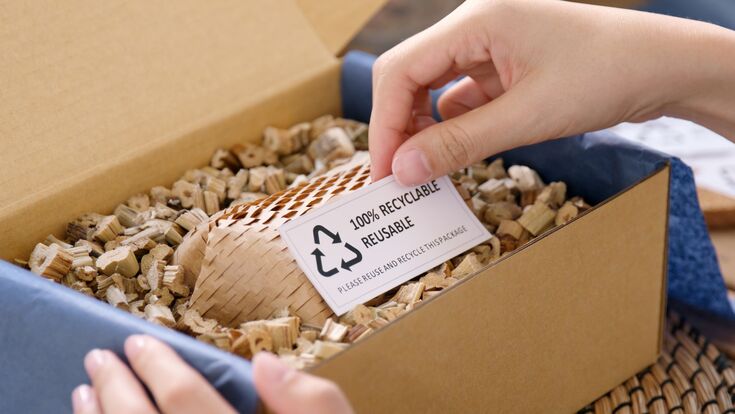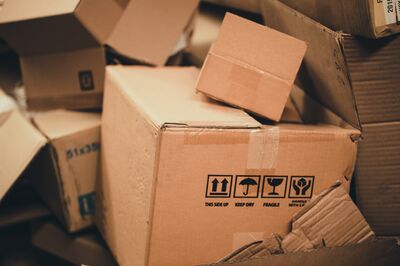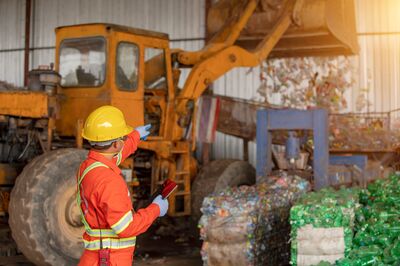Putting an end to wasteful packaging : The key points of the new EU Proposal for Packaging and Packaging Waste Regulation

Each European generates an average of almost 180 kg of packaging waste per year. Packaging is a major consumer of virgin materials, accounting for 40% of the plastics and 50% of the paper used in the EU. Unless action is taken, the EU will see a further 19% increase in packaging waste by 2030, and a 46% increase in plastic packaging waste.
In comes the new Packaging and Packaging Waste Regulation (PPWR) that the European Commission sees as an important tool to tackle this ever-growing problem.
The Packaging and Packaging Waste Regulation, also known as the Packaging Directive (PPWD), is a set of rules that the European Union (EU) has implemented to manage packaging and packaging waste in an environmentally sound manner. It was first adopted by EU in 1994 and has since been updated to include more ambitious targets for recycling and waste reduction. The most recent update to the directive was the adoption of the Single-Use Plastics Directive in 2019, which includes specific measures to reduce the environmental impact of certain single-use plastic products. As of July 3rd 2021 the EU no longer allows certain single-use plastic items such as cutlery, plates, straws, stirrers, cotton buds, food and beverage containers made of expanded polystyrene, and products made from oxo-degradable plastics, to be placed on the Member States market. The Directive requires Member States to take action to curb the consumption of these products, for example through consumption reduction targets, design requirements and labelling requirements. The Directive also requires Member States to introduce extended producer responsibility schemes for certain single-use plastic products.
Interested in our content? Subscribe to our newsletters!
Revision of the PPWD
But the EU wants to go even further. In the European Green Deal and subsequently, in the new Circular Economy Action Plan, the European Commission has committed itself to some very ambitious targets. For example, to develop requirements that will ensure that all packaging in the EU market is reusable or recyclable in an economically sound manner by 2030. The Commission has therefore chosen to revise the current PPWD. To start, the Commission has decided that a regulation and not a directive would be the best way to address the legislative challenges. The difference it easily explained: A directive defines objectives to be achieved by EU Member States and allows flexibility in the way these objectives are achieved, while a regulation is directly applicable and mandatory in its entirety and aims to achieve uniformity in the application of EU law across the EU.
Until February 1st the proposal was open for public discussion. It has then been sent to the European Parliament and the Council for consideration. The next steps in the legislative process are underway. Due to the complexity of the dossier, the legislative work of the co-legislators is expected to be rather lengthy and may even take more than a year to complete.
The Commission identified three highly interlinked problems that are hindering the circularity of packaging:
- Low levels of packaging recyclability
- High and growing level of packaging waste
- Low levels of uptake of recycled content
Therefore, the proposal introduces a number of new rules for packaging marketed in the EU, addressing in particular its:
- Recyclability
- Reusability
- Size
- Uptake of recycled content
"Each day we produce half a kilogram of packaging waste per person. With the new rules we propose crucial steps to make sustainable packaging the norm in the EU," said Virginijus Sinkevičius, Commissioner for Environment, Oceans and Fisheries. "We will create the right conditions for the circular economy principles - reduce, reuse, recycle - to work. More sustainable packaging and bioplastics are about new business opportunities in the green and digital transition, about innovation and new skills, local jobs and savings for consumers.
The proposal will also end confusion about which packaging belongs in which recycling bin. All packaging will carry a label indicating what it is made of and where it should go in the waste stream. The same labels will be placed on waste collection containers. The same symbols will be used throughout the EU.
For further reading go to our article on the harmonised bin symbols!
Each day we produce half a kilogram of packaging waste per person. With the new rules we propose crucial steps to make sustainable packaging the norm in the EU. We will create the right conditions for the circular economy principles - reduce, reuse, recycle - to work. More sustainable packaging and bioplastics are about new business opportunities in the green and digital transition, about innovation and new skills, local jobs and savings for consumers.Virginijus Sinkevičius, Commissioner for Environment, Oceans and Fisheries
Recylability
According to the proposal, all packaging put on the EU market will have to be recyclable. In order to be considered "recyclable", packaging will have to meet the following requirements:
- Designed for recycling (from 1 January 2030)
- Be collected separately
- Have the capacity to be recycled on a large scale (from 1 January 2035)
- Have the potential to be recycled in such a way that the secondary raw materials obtained are of sufficient quality to replace the primary raw materials.
Secondary legislation will be required to allow the translation of the above into practical examples. For example design-for-recycling is not yet specified. Furthermore, the Commission wants to establish a so-called recycling performance system. Packaging will be graded according to their recyclability from A to E. E meaning non-recyclable and therefore banned from the EU market.

Reusability
The PPWR proposal wants all packaging placed on the EU market to be designed and used to maximise reuse. Specific reusability targets will apply to the catering and e-commerce sectors and will also affect transport packaging.
Retailers placing reusable packaging on the market will have to guarantee that a reuse system is in place for such packaging. For example, consumer packaging for alcoholic and non-alcoholic beverages (excluding wine) will have to meet a reusability target of 10%, rising to 25% in 2040. Even stricter rules will apply to food take-away packaging, which will have to meet a 40% reusability target by 2040.
For transport packaging, a 100% reusability target will apply to the transport of products:
- within a Member State
- between various sites of the same business or between business and its affiliates or partners
This applies to pallets, boxes - excluding cardboard - trays, plastic crates, intermediate bulk containers, drums and canisters of all sizes and materials, including flexible formats, used for the transport of packaging for products placed on the market for the first time via e-commerce, and will be 10% from January 2030 and 50% from January 2040.
Size of Packaging
Every packaging unit must be reduced to its minimum size in terms of weight and volume. The empty space ratio (the difference between the total volume of the grouped, transport or e-commerce packaging and the volume of the sales packaging inside) does not exceed 40%.
European citizens are eager to be rid of overpackaging and unnecessarily bulky packages, and businesses are ready to move forward with sustainable, innovative packaging solutions and systems.Frans Timmermans, Executive Vice-President for the European Green Deal
Recycled Content
Plastic parts in packaging will need to contain a certain amount of recycled content.
From 1 January 2030:
- 10% for contact sensitive plastic packaging made of materials other than PET, except single use plastic (SUP) drinks bottles
- 30% for contact sensitive plastic packaging with PET as the main component
- 30% for SUP bottles
- 35% for other plastic packaging
from 1 January 2040
- 50% for contact sensitive plastic packaging other than SUP beverage bottles
- 65% for SUP bottles
- 65% for other plastic packaging
Stay connected - subscribe to our newsletters!
The Commission wants to establish a method for the calculation and verification of the percentage of recycled content recovered from post-consumer plastic waste per unit of plastic packaging, as well as the format of the corresponding technical documentation, no later than 31 December 2026. The plastic and plastic recycling industry very much favours the so-called mass balance approach.
Under the mass balance approach, recycled material is mixed with virgin material in a production process, and the resulting output is allocated a percentage of recycled content based on the proportion of recycled material used in the production process. This approach allows manufacturers to use recycled material in their products without needing to physically separate and track the recycled material throughout the production process.
Restrictions on the use of packaging formats
The PPWR proposal prohibits the following types of disposable packaging:
- Packaging for <1.5 kg of fresh fruit and vegetables
- Packaging for food and drink to be filled and consumed on the premises of hotels and restaurants
- Small hotel packaging for cosmetic, hygiene and toiletry products (<50 ml for liquids or <100 g for non-liquids)xtagstartz/strong>
- Single-portion or single-serving packaging used in the catering sector for condiments, preserves, sauces, coffee cream, sugar and spices.
Reactions of the waste management industry
The waste management industry has generally reacted positively to the European Commission's proposal. The higher recycling targets could lead to new business opportunities in the sector, including the development of new recycling technologies and the expansion of recycling infrastructure.
In addition, the proposed regulation could encourage the use of more sustainable packaging materials, such as reusable and biodegradable materials. This could lead to a reduction in the use of single-use plastics and other materials that are difficult to recycle.
However, some stakeholders have expressed concerns about the cost and feasibility of meeting the proposed recycling targets, particularly in countries with lower recycling rates. Other concerns have been raised about potential trade-offs between recycling and other waste management options, such as energy from waste and landfill.
Overall, the waste management industry recognises the need for a more sustainable approach to packaging waste management and supports the proposed regulation as a way to promote this goal. However, there is still some debate and discussion about the details of the proposed regulation and how it will be implemented in practice.


